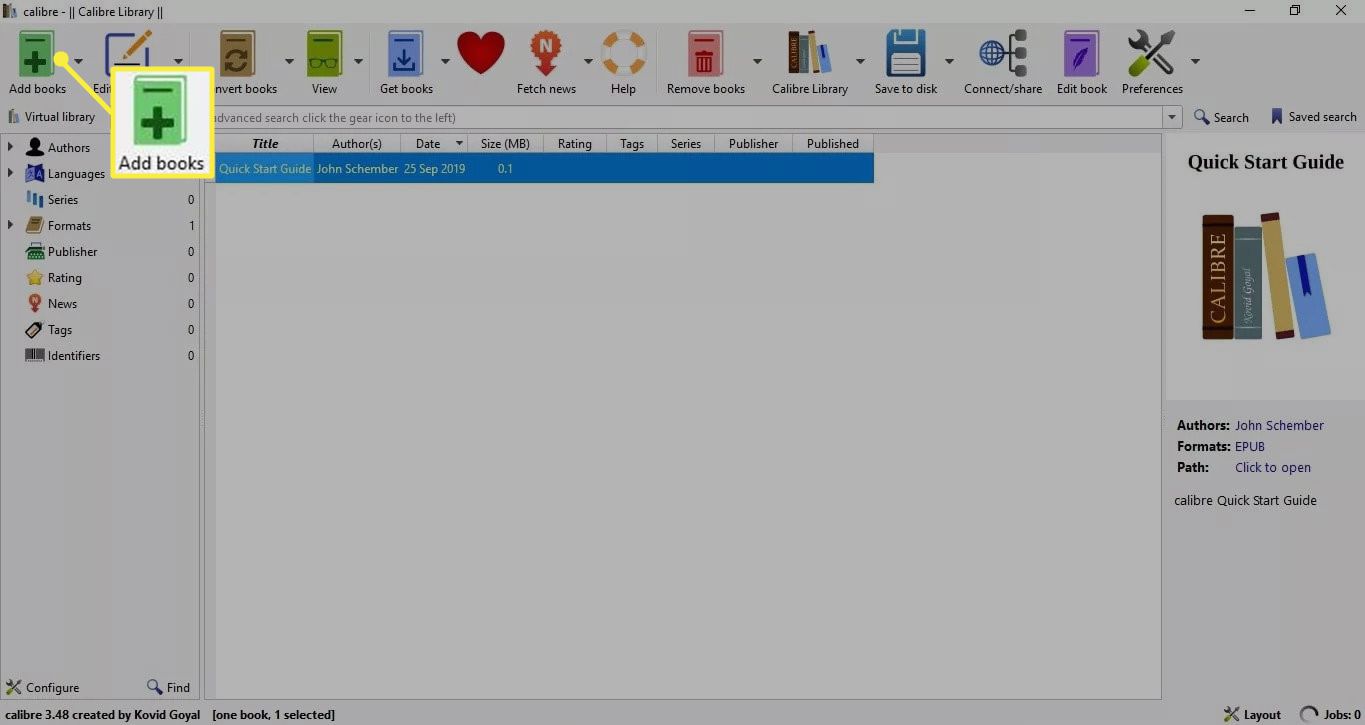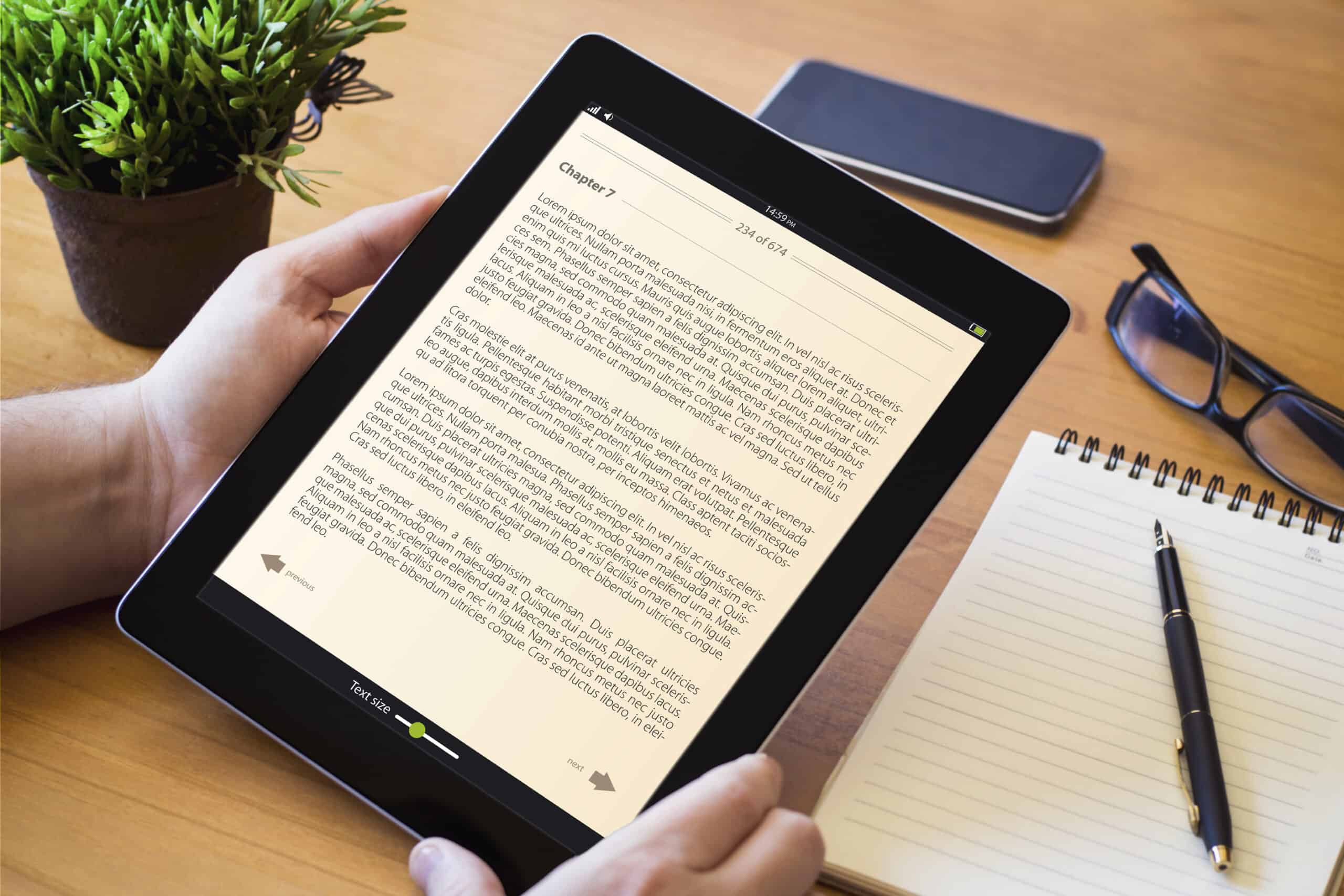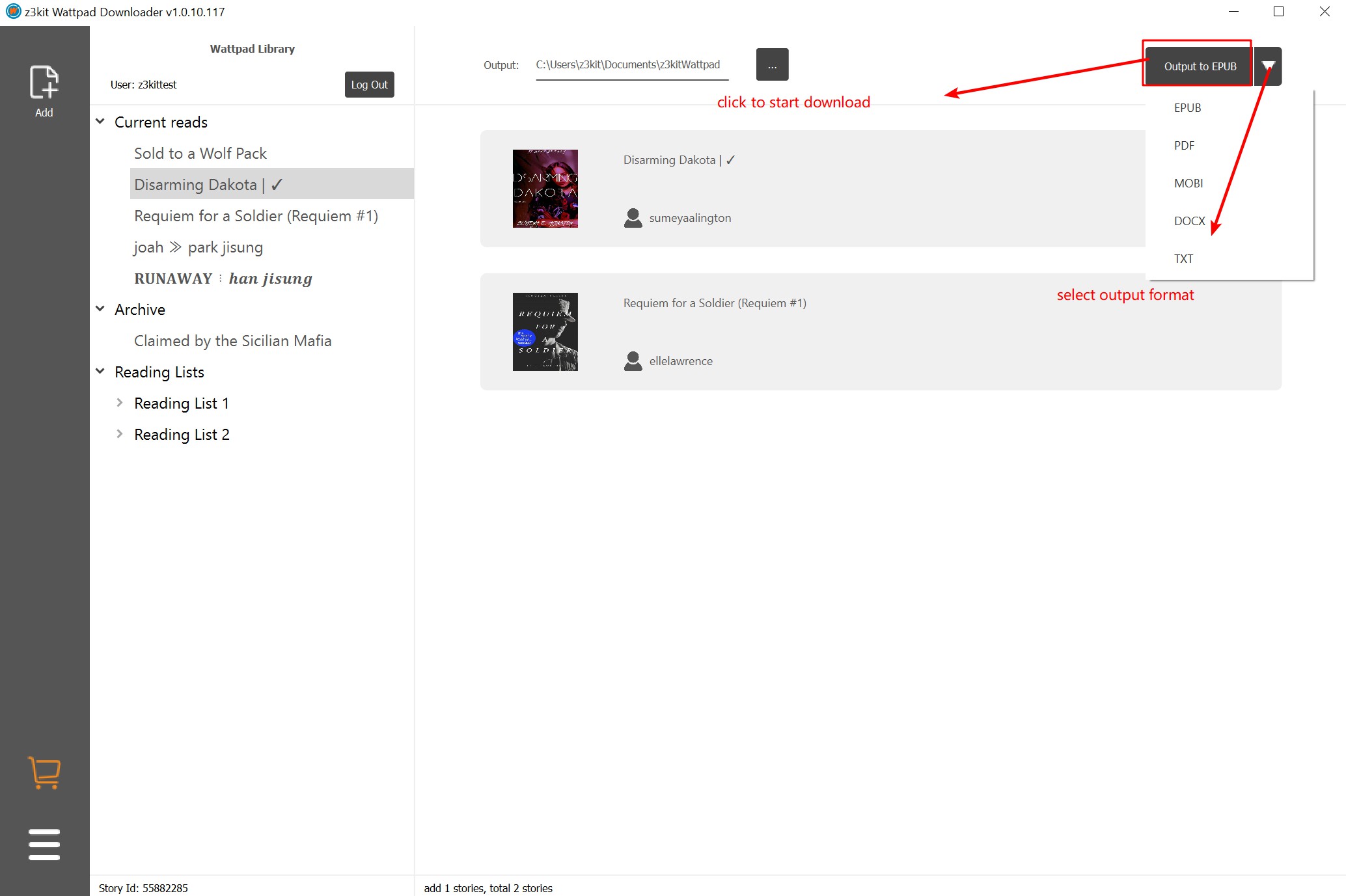Introduction
Welcome to the world of eBooks! In this digital age, eBooks have revolutionized the way we read and consume information. Gone are the days of carrying around bulky books or searching for a specific page in a printed document. With just a few clicks, you can now convert a PDF file into an eBook, making it easily accessible on various devices such as e-readers, tablets, and smartphones.
But why would you even want to convert a PDF into an eBook? Well, there are several reasons. First, eBooks offer a more interactive reading experience. You can zoom in on text, bookmark pages, highlight passages, and even search for specific keywords. Additionally, eBooks are highly portable and can be carried around in a single device, allowing you to have your entire library at your fingertips.
Another advantage of converting a PDF into an eBook is the ability to customize the reading experience. By converting your PDF file, you can adjust the font size, choose different font styles, change the background color, and even adjust the brightness. This level of customization ensures that readers have a comfortable and enjoyable reading experience tailored to their preferences.
Now that we understand the benefits, let’s dive into the process of converting a PDF into an eBook. In the next sections, we will explore the different conversion tools available, the steps to convert your PDF file, and the various formatting options to enhance your eBook. We will also discuss adding interactive elements, optimizing images and graphics, and adding metadata to your eBook. Lastly, we will cover testing and proofreading your eBook and uploading it to online platforms. By the end of this guide, you will be equipped with the knowledge and tools to successfully convert your PDF into an engaging eBook.
So, are you ready to embark on this exciting journey of converting your PDFs into captivating eBooks? Let’s get started!
Why Convert PDF into eBook?
PDF (Portable Document Format) files are widely used for sharing documents due to their ability to maintain the original formatting across different devices and operating systems. However, converting a PDF into an eBook format offers several benefits that make it worth considering. Let’s explore why you should convert your PDF into an eBook.
1. Enhanced Reading Experience: eBooks provide a more interactive reading experience compared to PDFs. With eBook features such as adjustable font sizes, bookmarking, highlighting, and text-to-speech capabilities, readers can customize their reading experience to suit their preferences. This flexibility makes eBooks more accessible and enjoyable for a broader range of readers.
2. Portability and Convenience: Carrying around a physical document or a laptop to read a PDF can be cumbersome. On the other hand, eBooks can be stored on devices such as e-readers, tablets, or smartphones, allowing you to access your documents anytime, anywhere. This portability and convenience make eBooks a preferred choice for readers who are always on the go.
3. Multi-platform Compatibility: While PDFs can be viewed on most devices, they may not always render correctly on smaller screens or different e-reading applications. Converting your PDF into an eBook format ensures compatibility across various platforms, guaranteeing that your content will look and function consistently, regardless of the device or software used to access it.
4. Interactive Elements: One of the significant advantages of converting a PDF into an eBook format is the ability to add interactive elements. eBooks support multimedia features like audio, video, hyperlinks, and interactive quizzes, enabling you to create a more engaging and immersive reading experience for your audience.
5. Monetization Opportunities: If you have valuable content that you wish to sell or distribute, converting it into an eBook can open up new monetization opportunities. You can publish your eBook on popular online platforms, such as Amazon Kindle or Apple Books, and reach a wider audience. This can potentially generate passive income and establish you as an expert in your field.
By converting your PDF into an eBook, you can take advantage of these benefits and transform your static document into an interactive and engaging reading experience. In the next sections, we will explore the different tools and steps required to convert your PDF into an eBook and discuss how to optimize it for a seamless reading experience. So, let’s dive in and unlock the full potential of your content!
Choosing the Right Conversion Tool
When it comes to converting a PDF into an eBook, choosing the right conversion tool is crucial. The conversion tool you select will determine the quality, functionality, and compatibility of your eBook. Here are some factors to consider when choosing a conversion tool:
1. Format Support: Make sure the conversion tool supports the eBook format you intend to use. The most common eBook formats are ePub and MOBI. ePub is widely supported across multiple devices and platforms, while MOBI is specifically designed for Amazon Kindle. Depending on your target audience and distribution platform, choose a tool that supports the appropriate formats.
2. Conversion Accuracy: The conversion tool should accurately preserve the formatting and layout of your PDF during the conversion process. It should handle complex elements such as tables, images, footnotes, and headers without introducing any errors or distortions. Test the tool with a sample PDF to ensure it maintains the integrity of your content.
3. Customization Options: Look for a conversion tool that allows you to customize the appearance and functionality of your eBook. It should offer options to adjust font sizes, styles, colors, and margins. Additionally, check if the tool supports the inclusion of interactive elements like hyperlinks, audio, video, and interactive quizzes. The more customization options available, the better control you have over the final output.
4. User-Friendliness: Consider the ease of use and user interface of the conversion tool. A user-friendly tool with a clear and intuitive interface will streamline the conversion process and make it easier for you to navigate through the various settings and options. Look for a tool that provides step-by-step instructions or tutorials to guide you through the conversion process.
5. Output Quality: The conversion tool should generate high-quality and well-optimized eBooks. Check if the tool optimizes images and graphics for different screen sizes and resolutions. The resulting eBook should be visually appealing, with crisp and clear text, images, and other visual elements. Assess the quality of the output before finalizing your conversion tool.
6. Customer Support and Updates: Consider the availability of customer support and regular updates for the conversion tool. If you encounter any issues or have questions during the conversion process, reliable customer support can guide you through. Additionally, a tool that receives regular updates indicates that the developers are actively addressing bugs and improving the functionality.
Take your time to research and compare different conversion tools, reading user reviews and checking out the features and functionalities they offer. It’s also a good idea to try out the free trial versions of the tools to get a hands-on experience before making a purchase. Remember, choosing the right conversion tool will significantly impact the quality and success of your eBook. So, invest time and effort into finding the tool that best suits your needs and requirements.
Converting PDF to eBook Format
Now that you’ve chosen the right conversion tool, it’s time to dive into the process of converting your PDF into an eBook format. Here are the general steps to follow:
1. Prepare Your PDF: Before converting, ensure that your PDF is properly formatted and organized. Check for any errors, spelling mistakes, or inconsistent formatting. It’s a good idea to create a backup copy of your original PDF file in case any issues arise during the conversion process.
2. Launch the Conversion Tool: Open the conversion tool you have selected. Depending on the tool, you may need to create a new project or import your PDF file directly into the tool’s interface.
3. Customize Conversion Settings: Most conversion tools offer customization options for things like font size, font style, margins, and more. Adjust these settings according to your preferences and the reading experience you want to create for your eBook. Take into consideration the target audience and the devices they are likely to use for reading.
4. Specify eBook Format: Choose the eBook format you want to convert your PDF into, such as ePub or MOBI. Select the appropriate format based on your target devices and distribution platforms. Each conversion tool may have slightly different format options, so familiarize yourself with the available choices.
5. Start the Conversion Process: Once you’ve customized the settings and specified the output format, initiate the conversion process. The time it takes to convert your PDF into an eBook will vary depending on the size and complexity of your PDF file. Be patient and let the tool do its work.
6. Validate and Review the eBook: After the conversion is complete, review the resulting eBook for any errors, layout issues, or missing elements. Check if the formatting, images, and interactive elements have been retained correctly. Make any necessary adjustments or corrections using the tool’s editing features.
7. Save the eBook: Once you are satisfied with the conversion and reviewed any changes made, save the eBook in your desired location. Consider creating separate folders for different eBook formats if you plan to distribute your eBook on multiple platforms.
8. Test the eBook: Before distributing your eBook, it’s essential to test it on different devices and e-reader applications to ensure compatibility and a seamless reading experience. Pay attention to formatting, readability, and functionality, and make any further adjustments if needed.
With these steps, you can successfully convert your PDF into an eBook format. Remember to refer to the user guide or documentation provided with the conversion tool for specific instructions and features. In the next sections, we will explore the various formatting options and techniques to enhance your eBook and make it more engaging for readers.
Formatting Your eBook
Formatting plays a crucial role in creating an appealing and readable eBook. Proper formatting ensures that your content is presented in a consistent and visually pleasing manner across different devices and e-reader applications. Here are some key aspects to consider when formatting your eBook:
1. Font and Typography: Choose a font that is easy to read on screens and consider the font size to ensure comfortable reading. Stick to standard fonts like Arial, Times New Roman, or Calibri, as they are widely supported. Use bold, italics, and underline sparingly to emphasize important text or headings.
2. Paragraph and Line Spacing: Use appropriate paragraph and line spacing to enhance readability. Avoid long paragraphs by breaking them into smaller, more digestible chunks. Leave a blank line between paragraphs to give readers a visual break and improve clarity.
3. Page Breaks: Ensure that each chapter or section starts on a new page. Insert page breaks whenever necessary to maintain a clean and organized layout. Page breaks also help readers navigate through the eBook more easily.
4. Headers and Footers: Include headers and footers with relevant information, such as the book title, chapter headings, or page numbers. These elements provide context and aid in navigating the eBook. However, avoid placing unnecessary or distracting information in the headers and footers.
5. Table of Contents: Include a comprehensive table of contents that allows readers to navigate through different chapters or sections of the eBook. Ensure that the table of contents is hyperlinked, enabling readers to click on a chapter or section title and jump directly to that part of the eBook.
6. Lists and Bullet Points: Use bulleted or numbered lists to present information in a structured and easy-to-read format. Lists help break down complex information and make it more scannable for readers. However, avoid using lists excessively and keep them concise.
7. Images and Graphics: Optimize images and graphics for the eBook format, ensuring they are of high quality and appropriately sized. Use image formats supported by eBook readers, such as JPEG or PNG. Position images strategically within the text to complement the content and enhance visual appeal.
8. Hyperlinks: If your eBook contains hyperlinks, make sure they are functional and properly formatted. Check that the hyperlinks direct readers to the correct webpages or external sources. Use descriptive anchor text to guide readers and provide context for the linked content.
9. Consistent Styling: Maintain a consistent visual style throughout the eBook. Use the same font, font size, heading styles, and colors consistently to create a cohesive and professional look. Consistent styling helps establish a sense of unity and professionalism for your eBook.
Remember to regularly preview your eBook on different devices and platforms to ensure that the formatting appears as intended. Making formatting adjustments in small increments and testing frequently will help you achieve the desired presentation for your eBook. In the next sections, we will discuss how to add interactive elements and optimize images and graphics in your eBook, further enriching the reading experience.
Adding Interactive Elements
An eBook offers a unique opportunity to enhance reader engagement by incorporating interactive elements. These elements can make your eBook more immersive, interactive, and enjoyable for the readers. Here are some popular interactive elements to consider adding to your eBook:
1. Hyperlinks: Add hyperlinks within the eBook to redirect readers to additional resources, websites, or related content. Hyperlinks can provide more context, expand on a topic, or offer further reading options, enriching the reader’s experience.
2. Audio and Video: Embedding audio and video files can create a multimedia experience for your readers. You can include audio clips of interviews or background music that adds depth to your content. Similarly, embedding videos can provide visual demonstrations, interviews, or tutorials related to the subject matter.
3. Quizzes and Assessments: Incorporating interactive quizzes or assessments can help readers test their understanding of the content. You can include multiple-choice questions, fill-in-the-blanks, or even true/false questions. Consider providing feedback on the quiz results to ensure a valuable learning experience.
4. Interactive Graphics: Use interactive graphics, such as maps, infographics, or graphs, to present complex information in a visually engaging manner. Enable readers to interact with the graphics by zooming in, panning, or exploring data points. This interactivity allows readers to explore the content at their own pace and gain a deeper understanding.
5. Interactive Table of Contents: Enhance the usability of your eBook by making the table of contents interactive. Allow readers to directly navigate to different chapters or sections by clicking on the respective titles in the table of contents. This feature enables easy and quick navigation within the eBook.
6. Bookmarking and Note-taking: Provide the option for readers to bookmark pages or sections they find important or want to revisit later. Additionally, enable note-taking capabilities, allowing readers to jot down their thoughts or insights while reading. These features enhance personalization and make it easier for readers to refer back to specific content.
When incorporating interactive elements, it’s important to strike a balance. Use them purposefully and align them with the content. Remember that excessive interactivity can be overwhelming and distract readers from the main focus of your eBook. Keep the interactive elements relevant, engaging, and supportive of the overall learning or reading experience.
Before finalizing your eBook, thoroughly test the interactive elements on different devices and platforms to ensure they function as intended. Consider providing clear instructions or tooltips to guide readers on how to interact with the elements, ensuring a seamless user experience.
Now that you have learned how to add interactive elements to your eBook, let’s explore the next step: optimizing images and graphics to enhance the visual appeal of your eBook.
Optimizing Images and Graphics
Images and graphics play a crucial role in enhancing the visual appeal of your eBook. However, it’s essential to optimize them properly to ensure optimal performance and readability. Here are some key considerations for optimizing images and graphics in your eBook:
1. Image File Formats: Select the appropriate file format for your images. For photographs or complex images with many colors, JPEG is often the preferred format. If your image has a transparent background or requires line art and text, consider using PNG format. Use vector graphics (SVG) for illustrations and logos as they can be scaled without losing quality.
2. Image Size and Resolution: Resize your images to fit the dimensions of your eBook without compromising quality. Avoid large file sizes that may slow down the loading time of your eBook. Optimize the resolution based on the target device’s screen resolution to ensure a crisp display without unnecessary file bloat.
3. Compression: Compress your images to reduce file sizes while maintaining acceptable image quality. Use compression tools or software to strike a balance between file size and visual clarity. Be cautious not to over-compress the images, as it may result in loss of details or artifacts.
4. Image Placement: Carefully position images within your eBook. Ensure that images are relevant to the content and caption them appropriately if necessary. Place images near the related text to provide context and improve comprehension. Consider the flow of your eBook and strive for a visually pleasing layout.
5. Alt Text: Add ALT text (alternative text) to your images. Alt text is essential for accessibility purposes, allowing visually impaired readers or those using assistive technologies to understand the content of the images. Make alt text concise, descriptive, and informative to provide meaningful context.
6. Consistency: Maintain visual consistency throughout your eBook. Use a similar style, tone, and quality for all the images to create a cohesive reading experience. Consistent image formatting enhances the overall professionalism and aesthetics of your eBook.
7. Test on Different Devices: Preview your eBook on various devices and e-reader applications to ensure the images appear as intended. Check for any scaling or rendering issues, and make any necessary adjustments to improve the image display and overall readability.
Remember, images and graphics should enhance your content, not overshadow it. Choose images that are relevant and support the message you want to convey. Additionally, be mindful of copyright laws when using images and ensure you have appropriate permissions or use royalty-free images. Finally, always proofread your eBook for any image-related issues before publishing or distributing it.
By optimizing your images and graphics, you can create a visually captivating and engaging eBook that enhances the overall reading experience. In the next section, we will discuss how to add metadata to your eBook to provide relevant information and improve its discoverability.
Adding Metadata
Metadata is essential for providing relevant information about your eBook and improving its discoverability. Adding metadata ensures that your eBook is properly categorized and indexed by search engines and online platforms. Here are some key metadata elements to consider adding to your eBook:
1. Title and Subtitle: Provide a descriptive and concise title for your eBook that accurately represents its content. If applicable, include a subtitle that further clarifies the topic or focus. A compelling title and subtitle can attract readers and give them an idea of what to expect from your eBook.
2. Author Name: Include the author’s name or names who are responsible for creating the eBook. This helps establish credibility and recognition for both readers and search engines. If there are multiple authors, separate their names using commas.
3. Description: Craft a compelling and informative description that summarizes the main points, benefits, and unique features of your eBook. The description should captivate potential readers and entice them to explore further. Consider incorporating relevant keywords naturally into the description to enhance discoverability in search engines.
4. Keywords: Choose relevant keywords that accurately represent the content and topic of your eBook. These keywords will help potential readers find your eBook when searching on platforms or search engines. Conduct keyword research to identify the most effective and appropriate keywords to include.
5. Categories and Genres: Select the appropriate categories and genres that align with the content of your eBook. This helps readers discover your eBook when browsing through specific categories or genres. Choose categories and genres that are relevant and commonly used within the industry or subject matter.
6. ISBN (International Standard Book Number): If you have obtained an ISBN for your eBook, include it in the metadata. An ISBN is a unique identifier that helps identify your eBook in databases, libraries, and online stores. It can also enhance the professional appearance and marketability of your eBook.
7. Language: Specify the language in which your eBook is written. Indicating the language ensures that readers who search for eBooks in specific languages can find your eBook more easily.
8. Publication Date: Include the publication date of your eBook. This allows readers to identify the most recent publications and helps organize your eBook within online platforms.
9. Author Bio: Provide a brief author biography to give readers insight into the background and expertise of the author. Include relevant qualifications, accomplishments, or other notable information that establishes credibility and connects with the readers.
Ensure that the metadata you add is accurate and up-to-date. Verify the metadata requirements and guidelines of the platforms or distribution channels where you plan to publish your eBook. Consistent and well-optimized metadata are crucial for improving the discoverability and visibility of your eBook in search results and online marketplaces.
Once you have added the necessary metadata, it’s time to test and proofread your eBook to ensure its quality and accuracy. In the next section, we will cover the important steps of testing and proofreading your eBook before finalizing and publishing it.
Testing and Proofreading Your eBook
Before finalizing and publishing your eBook, it’s crucial to thoroughly test and proofread it to ensure a professional and error-free reading experience. Here are the important steps to follow for testing and proofreading:
1. Test on Different Devices: Validate your eBook on various devices and e-reader applications to ensure compatibility and proper rendering. Check how the eBook appears on different screen sizes, orientations, and platforms to identify any formatting or layout issues that may need adjustment.
2. Check Formatting and Layout: Carefully review the formatting and layout of your eBook. Check for any inconsistencies, spacing issues, or alignment problems. Ensure that headers, footers, paragraphs, and images are correctly positioned and aligned. Pay attention to font styles, sizes, and colors to maintain consistency throughout the eBook.
3. Proofread for Errors: Thoroughly proofread your eBook to eliminate any grammatical errors, spelling mistakes, or typos. Check for punctuation, syntax, and readability. It’s helpful to have someone else review your eBook as well, as fresh eyes may catch errors you may have missed.
4. Validate Links and Navigation: Click on all the hyperlinks in your eBook to verify that they work correctly and lead to the intended locations. Check the navigation within the eBook, including the table of contents and any internal links, to ensure smooth and seamless browsing for the readers.
5. Review Images and Graphics: Examine all the images and graphics in your eBook to ensure they are correctly displayed, properly aligned, and still relevant to the content. Make sure they are not pixelated or distorted and that they contribute positively to the overall reading experience.
6. Test Interactive Elements: If your eBook contains interactive elements like quizzes, assessments, or multimedia files, thoroughly test them for functionality. Ensure that interactive elements function as expected and enhance the overall user experience.
7. Check Metadata: Review the metadata of your eBook, including the title, description, author information, keywords, and other relevant details. Ensure that all metadata is accurate, up-to-date, and optimized for discoverability.
8. Double-Check Table of Contents: Verify that the table of contents accurately reflects the structure and organization of your eBook. Ensure that each chapter or section title links to the corresponding content within the eBook.
9. Consider User Experience: Put yourself in the readers’ shoes and evaluate the overall user experience. Consider readability, navigation, and accessibility. Seek feedback from beta readers or individuals who represent your target audience to gather valuable insights and make necessary improvements.
Testing and proofreading may require several iterations, but it is an essential step in ensuring a polished and professional eBook. Take your time to carefully go through each aspect of the eBook and make the necessary adjustments. Keep in mind that even minor errors or formatting inconsistencies can impact the overall reading experience and diminish the credibility of your eBook.
Once you are satisfied with the results of testing and proofreading, it’s time to proceed to the final step: uploading and distributing your eBook on various online platforms. We will cover this in the next section.
Uploading Your eBook to Online Platforms
After thoroughly testing and proofreading your eBook, the next step is to upload and distribute it on online platforms. Here is a step-by-step guide to help you navigate the process of uploading your eBook:
1. Research Online Platforms: Explore different online platforms that cater to eBook distribution, such as Amazon Kindle Direct Publishing, Apple Books, Barnes & Noble Nook Press, or Kobo Writing Life. Research each platform’s terms, royalty rates, and audience reach to determine the best fit for your eBook.
2. Create an Account: Once you have selected the platform(s) you want to publish on, create an account or sign in if you already have one. Follow the platform’s guidelines for setting up your author account and providing the necessary information requested.
3. Format Your eBook: Ensure that your eBook is in the correct format based on the platform’s requirements. Most platforms accept ePub files, but some may have specific formatting guidelines. Follow the platform’s instructions on formatting and preparing your eBook for upload.
4. Provide Metadata: Enter the required metadata for your eBook, including the title, author name, description, categories, and keywords. Take the time to craft a compelling and accurate description that attracts potential readers and highlights the unique aspects of your eBook.
5. Upload Your eBook: Use the platform’s interface or dashboard to upload your eBook file. Follow the step-by-step instructions provided by the platform to ensure a smooth and successful upload process. Some platforms may require additional information or allow you to preview your eBook before finalizing the upload.
6. Set Pricing and Royalties: Determine the pricing of your eBook and select the royalty rates offered by the platform. Consider factors such as market demand, competition, and the value you believe your eBook offers. Some platforms also offer promotional tools or pricing options, so explore the available options and make informed decisions.
7. Review and Confirm: After uploading your eBook and setting the necessary details, carefully review all the information on the platform’s confirmation page. Ensure that all the metadata, pricing, and royalty settings are accurate before proceeding with the publishing process.
8. Publish Your eBook: Once you are satisfied with the information and settings, click the publish button or follow the platform’s instructions to make your eBook available for sale or distribution. Keep in mind that publishing times may vary across platforms, so be patient while your eBook goes through the review and publishing process.
9. Promote Your eBook: After publishing, take an active role in promoting your eBook to reach your target audience. Utilize social media, email newsletters, your website or blog, and other marketing channels to generate awareness and drive sales. Engage with readers and take advantage of promotional opportunities provided by the platform.
10. Monitor Performance: Keep track of your eBook’s performance using the platform’s reporting and analytics tools. Monitor sales, reviews, and reader feedback to assess the success of your eBook and make informed decisions about future publishing endeavors.
Remember to adhere to each platform’s guidelines, terms of service, and copyright regulations when uploading your eBook. Regularly update and maintain your eBook’s presence on the platforms to ensure its visibility and availability.
Congratulations on successfully uploading your eBook! In the final section, we will summarize the key points we have covered and offer some closing thoughts. Stay tuned!
Conclusion
Congratulations on completing the journey of converting your PDF into an engaging eBook! Throughout this guide, we have explored the reasons why converting a PDF into an eBook is beneficial, the importance of choosing the right conversion tool, and the steps to convert your PDF into an eBook format. We have also discussed formatting techniques, adding interactive elements, optimizing images and graphics, adding metadata, and testing and proofreading your eBook. Finally, we covered the process of uploading your eBook to online platforms.
By converting your PDF into an eBook, you have transformed a static document into a dynamic and interactive reading experience for your audience. eBooks offer enhanced portability, customization options, and the potential for monetization, making them an excellent choice for sharing and distributing valuable content.
Throughout the conversion process, it’s crucial to keep the reader in mind. Focus on delivering a seamless and enjoyable reading experience by optimizing the formatting, incorporating interactive elements, and ensuring visual appeal with well-optimized images and graphics.
A successful eBook not only depends on the quality of the content but also the meticulous attention to detail during the conversion, formatting, and proofreading stages. Thorough testing and proofreading protect your eBook from potential errors and enhance its overall professionalism and credibility.
By leveraging the power of online platforms, you gain access to a broad audience and the opportunity to monetize your eBook. Take advantage of the various distribution channels available and promote your eBook to gain visibility and reach your target readers effectively.
Remember, the world of eBooks continues to evolve, and staying updated with the latest trends and technologies can further enhance your eBook creation and distribution process. Embrace new tools, features, and strategies to stay ahead in the competitive eBook market.
Now, armed with the knowledge and practical insights gained from this guide, you are ready to embark on your eBook publishing journey. Enjoy the process, be creative, and never stop refining your eBook to provide the best possible experience for your readers.
Best of luck with your eBook endeavors, and may your eBook bring joy, knowledge, and inspiration to readers around the world!

























